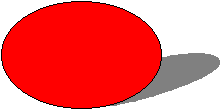Using the Shadow Element
This topic describes VML, a feature that is deprecated as of Windows Internet Explorer 9. Webpages and applications that rely on VML should be migrated to SVG or other widely supported standards.
Note
As of December 2011, this topic has been archived. As a result, it is no longer actively maintained. For more information, see Archived Content. For information, recommendations, and guidance regarding the current version of Windows Internet Explorer, see Internet Explorer Developer Center.
In this topic, we will illustrate how to use the <shadow> sub-element to draw a shape that has various shadow effects.
You can place the <shadow> sub-element inside the <shape>, <shapetype>, or any predefined shape element to draw a shape with a shadow. You can then use the property attributes of the <shadow> sub-element to customize the shadow.
For example, to create a shape with a shadow, as shown in the following picture, you can type the following lines in the <BODY> region of your Web page:

<v:oval style='width:120pt;height:80pt;' fillcolor="red">
<v:shadow on="t" type="perspective"
origin=".5,.5" offset="0,0"
matrix=",-92680f,,,,-95367431641e-17"/>
</v:oval>
on="t"andtype="perspective"indicate to turn on the shadow using the perspective type.- The origin and offset indicate where to draw the shadow.
matrix="..."specifies the perspective transform matrix.
For more information about this element, see the VML specification .
Feedback
Coming soon: Throughout 2024 we will be phasing out GitHub Issues as the feedback mechanism for content and replacing it with a new feedback system. For more information see: https://aka.ms/ContentUserFeedback.
Submit and view feedback for